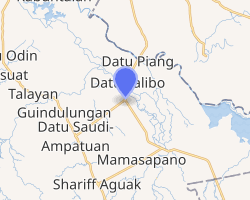Shariff Saydona Mustapha, Maguindanao
Shariff Saydona Mustapha, officially the Municipality of Shariff Saydona Mustapha (Maguindanaon: Ingud nu Shariff Saydona Mustapha; Iranun: Inged a Shariff Saydona Mustapha; Tagalog: Bayan ng Shariff Saydona Mustapha), is a — municipality in the province of Maguindanao, Philippines. According to the 2015 census, it has a population of 19,855 people.[3]
Shariff Saydona Mustapha | |
|---|---|
| Municipality of Shariff Saydona Mustapha | |

| |
.svg.png) Shariff Saydona Mustapha Location within the Philippines | |
| Coordinates: 6°58′34″N 124°28′53″E | |
| Country | |
| Region | Bangsamoro Autonomous Region in Muslim Mindanao (BARMM) |
| Province | Maguindanao |
| District | 2nd District |
| Barangays | 16 (see Barangays) |
| Government | |
| • Type | Sangguniang Bayan |
| • Mayor | Datu Sajid Islam U. Ampatuan |
| • Vice Mayor | Bai Zandria S. Ampatuan |
| • Congressman | Esmael G. Mangudadatu |
| • Electorate | 7,821 voters (2019) |
| Area | |
| • Total | 164.42 km2 (63.48 sq mi) |
| Population (2015 census)[3] | |
| • Total | 19,855 |
| • Density | 120/km2 (310/sq mi) |
| • Households | 3,568 |
| Economy | |
| • Income class | no value |
| • Poverty incidence | 51.98% (2015)[4] |
| • Revenue (₱) | 43,275.01 (2016) |
| Time zone | UTC+8 (PST) |
| ZIP code | 9608 |
| PSGC | |
| IDD : area code | +63 (0)64 |
| Climate type | tropical climate |
| Native languages | Maguindanao Tagalog |
It was created out of 4 barangays from the municipality of Shariff Aguak, 4 entire barangays and a portion of one barangay from Mamasapano, 2 barangays from Datu Unsay, one barangay from Datu Piang, and 3 entire barangays and a portion of one barangay from Datu Saudi-Ampatuan by virtue of Muslim Mindanao Autonomy Act No. 225[5] (as amended by MMAA Act No. 252), which was subsequently ratified in a plebiscite held on July 30, 2009.
Shariff Saydona Mustapha was an Arab missionary from Mecca and a paternal uncle of Shariff Kabungsuwan of Johore (the first Sultan of Maguindanao). He arrived in Mainland Mindanao in the mid-15th century. He is the ancestor of the Ampatuan, Mangacop, Masukat and Sangki clans of Maguindanao.
Barangays
Shariff Saydona Mustapha is politically subdivided into 16 barangays.
- Bakat
- Dale-Bong
- Dasawao
- Datu Bakal
- Datu Kilay
- Duguengen
- Ganta
- Inaladan
- Libutan
- Linantangan
- Nabundas
- Pagatin
- Pagatin (Pagatin I)
- Pamalian
- Pikeg
- Pusao
Climate
| Climate data for Shariff Saydona Mustapha, Maguindanao | |||||||||||||
|---|---|---|---|---|---|---|---|---|---|---|---|---|---|
| Month | Jan | Feb | Mar | Apr | May | Jun | Jul | Aug | Sep | Oct | Nov | Dec | Year |
| Average high °C (°F) | 32 (90) |
32 (90) |
33 (91) |
33 (91) |
32 (90) |
31 (88) |
30 (86) |
31 (88) |
31 (88) |
31 (88) |
31 (88) |
31 (88) |
32 (89) |
| Average low °C (°F) | 21 (70) |
21 (70) |
21 (70) |
22 (72) |
23 (73) |
23 (73) |
23 (73) |
23 (73) |
23 (73) |
23 (73) |
23 (73) |
22 (72) |
22 (72) |
| Average precipitation mm (inches) | 19 (0.7) |
14 (0.6) |
15 (0.6) |
18 (0.7) |
33 (1.3) |
42 (1.7) |
44 (1.7) |
42 (1.7) |
30 (1.2) |
31 (1.2) |
28 (1.1) |
17 (0.7) |
333 (13.2) |
| Average rainy days | 6.9 | 5.6 | 6.9 | 8.1 | 15.1 | 17.5 | 17.8 | 18.5 | 14.9 | 14.9 | 12.4 | 8.0 | 146.6 |
| Source: Meteoblue [6] | |||||||||||||
Demographics
| Year | Pop. | ±% p.a. |
|---|---|---|
| 2010 | 16,442 | — |
| 2015 | 19,855 | +3.66% |
| Source: Philippine Statistics Authority[3][7][8][9] | ||
References
- "Municipality". Quezon City, Philippines: Department of the Interior and Local Government. Retrieved 31 May 2013.
- "Province: Maguindanao". PSGC Interactive. Quezon City, Philippines: Philippine Statistics Authority. Retrieved 12 November 2016.
- Census of Population (2015). "ARMM – Autonomous Region in Muslim Mindanao". Total Population by Province, City, Municipality and Barangay. PSA. Retrieved 20 June 2016.
- "PSA releases the 2015 Municipal and City Level Poverty Estimates". Quezon City, Philippines. Retrieved 12 October 2019.
- "Muslim Mindanao Autonomy Act No. 225; An Act Creating the Municipality of Shariff Saydona Mustapha in the Province of Maguindanao, Providing Funds Therefor, and for Other Purposes" (PDF). Regional Legislative Assembly, Autonomous Region in Muslim Mindanao. Retrieved 27 January 2016.
- "Shariff Saydona Mustapha, Maguindanao : Average Temperatures and Rainfall". Meteoblue. Retrieved 19 January 2019.
- Census of Population and Housing (2010). "ARMM – Autonomous Region in Muslim Mindanao". Total Population by Province, City, Municipality and Barangay. NSO. Retrieved 29 June 2016.
- Censuses of Population (1903–2007). "ARMM – Autonomous Region in Muslim Mindanao". Table 1. Population Enumerated in Various Censuses by Province/Highly Urbanized City: 1903 to 2007. NSO.
- "Province of Maguindanao". Municipality Population Data. Local Water Utilities Administration Research Division. Retrieved 17 December 2016.
External links
- Shariff Saydona Mustapha Profile at PhilAtlas.com
- MMA Act No. 225 : An Act Creating the Municipality of Shariff Saidona Mustapha in the Province of Maguindanao
- Philippine Standard Geographic Code
- 2007 Census Population Figures for Maguindanao
- COMELEC - Plebiscite results for 3 new Maguindanao towns
- COMELEC Resolution No. 8169